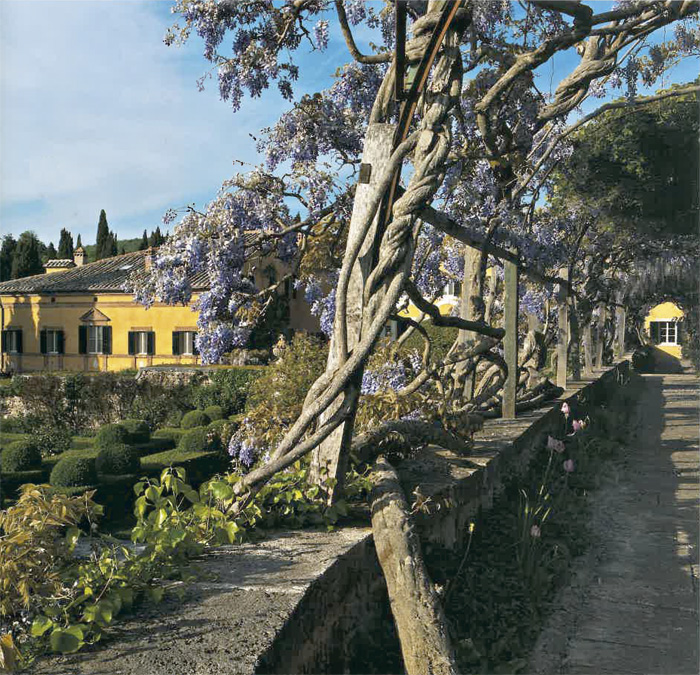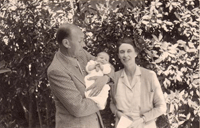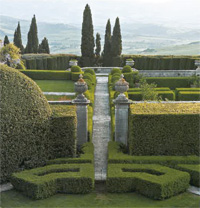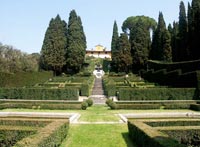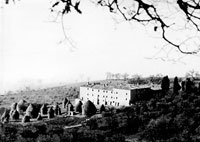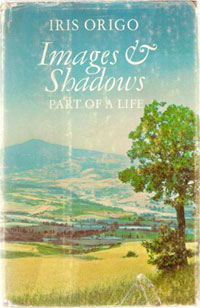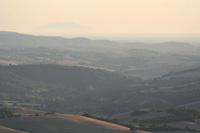Iris Origo and Villa La Foce |
The gardens and estate of La Foce constitute one of the most important and best kept early twentieth-century gardens in Italy. The property of La Foce lies on the hills overlooking the Val d'Orcia, a beautiful and miraculously intact valley in Southern Tuscany. |
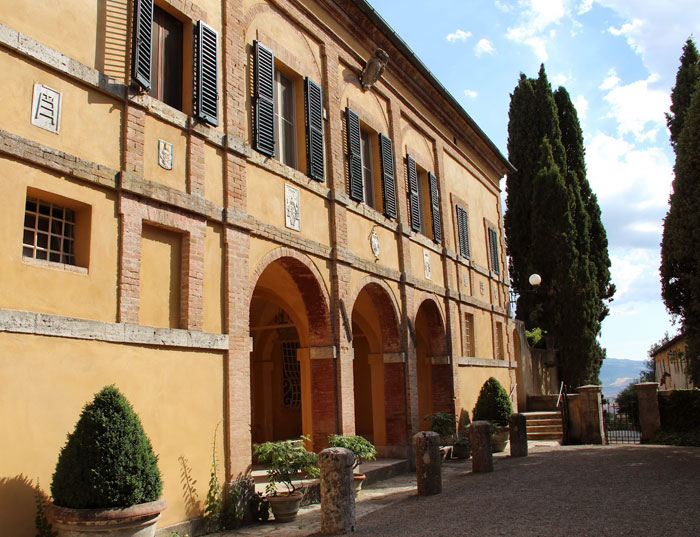 |
||
Villa La Foce |
||
'It was in this region, not far from Montepulciano and Pienza, that Iris Origo[1], an American woman married to an Italian aristocrat, spent 1943 and 1944 living on the family estate at La Foce. Here, Origo, her family, various hired hands, their families and as many as fifty-seven farmers (and their extended families) occupying the farms on the family estate across seven thousand acres witnessed the collapse of Mussolini’s government, the retreat of the German army, and the eventual allied victory during World War II.' |
|
|
After buying their new home, Antonio and Iris employed the services of English architect Cecil Pinsent. Iris already knew Cecil as he had worked on her mother's house, Villa Medici, in Fiesole, and the nearby house of friend Bernard Berenson, Villa I Tatti.
|
||
| The famous winding road with cypresses |
||
The cypresses that twine up a hill side near Chianciano Terme have become an emblem of Tuscany. But they also have a story, for they were planted by Marchese and Marchesa Origo as part of a scheme to improve the landscape of what was then among Italy's most desolate regions. They also, no doubt, softened the view from the masterpiece the idealistic young couple created nearby, at what had been until their arrival a wayside inn: one of the most dramatic twentieth-century gardens.
|
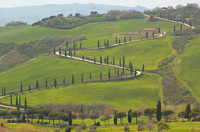 Winding road with cypresses between La Foce and Monticchiello 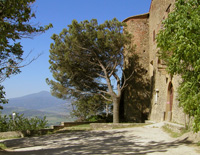 Castelluccio |
|
Villa La Foce enlarge map |
||||
|
||||
| [1] 'Iris Origo (née Cutting) was born in 1902. Her father, an American, died when she was seven. He wrote to her Anglo-Irish mother Sybil Desart: "All this national feeling makes people so unhappy. Bring her up somewhere where she does not belong … I'd like her to be a little 'foreign'." Origo was brought up in the Villa Medici in Fiesole. Her choice of husband, a man a decade her senior who "grew up in the laundry with the servants", was not what was expected of her at all. Her mother spent the wedding day in bed. When the Origos decided to live at La Foce, their friends and family thought they were mad. No one moved to the countryside like that, particularly not to such a ramshackle estate on a windswept hill, with no running water and – worst of all – no polite company. The desire to reconstruct a new society ("our shared youthful dream", as Origo referred to it) drove the couple. Their decision to do what they felt to be morally right, rather than what was socially acceptable among their class, came to be what La Foce and the Origos were remembered for, as one of the only aristocratic families in Italy who helped escaping prisoners, partisans and deserters during the second world war. In this, and in other ways, they were unique.' |
||||
| [2] Villa I Tatti | The famous art historian, Bernard Berenson, bought the Villa I Tatti in 1905 and (in 1909) commissioned two Englishmen (Cecil Ross Pinsent and Geoffrey Scott) to re-design the garden. Scott was famous as the author of a book on The Architecture of Humanism. Pinsent was a young and unknown architect. They began work at a time when Arts and Crafts designers, inspired by Blomfield, Sedding and others, were filled with enthusiasm for Italian renaissance gardens.The results of their work has many renaissance features, and a friendly pastiche charm, but it does not have the disciplined 'feel' of a genuine renaissance garden. It is now owned by Harvard University and they have a very restrictive policy regarding garden photography.
|
||||
| 'The estate of La Foce was located a hundred miles north of Rome, between Siena and Lake Trasimene. This particular area was carefully selected by the Origos because it was a barren region that could be improved by a planned program of intensive cultivation. The Val d’Orcia had been much neglected over the centuries, laid bare by soil erosion and desolated by wars between rival city-states. The new owners set about restoring it to life. Fifteen years of hard work resulted in the establishment of fifty farms, each of about a hundred acres, all grouped round one central fattoria where the Origo family lived and where all the general decisions were made about what crops to grow and what agricultural methods to adopt. Each tenant farmer held his individual farm by the usual Tuscan system of mezzadria, sharing all produce with the proprietor but depending on him for equipment and capital. While her husband introduced modern farming techniques and a rational system of cultivation, the Marchesa set up a health centre and a school for ninety children. Evening classes were also provided for adults. She found the valley a wild district, with over eighty per cent illiteracy, where the peasants were instinctively opposed to any innovation and where witches and witch-doctors helped to regulate the life of the population. But during these fifteen years, there was a gradual growth in prosperity, and the whole society began to change and develop.' [Denis Mack Smith, Introduction to War in Val d’Orcia: An Italian War Diary, 1943-1944 by Iris Origo] [4] Iris Origo, a plain girl who turned herself into a woman of great elegance, was, by all accounts, an obsessive writer. "She always wrote in the morning and came down to lunch in a terrible mood as she had to stop," her daughter Benedetta recalls. Several of her books were international bestsellers when published and many remain in print decades later. Origo is best known for her diary, War in the Val D'Orcia, and her ability, as critic and biographer Quentin Bell put it, "to bring even mountains to life," in her biographical work, such as The Merchant of Prato: Francesco Di Marco Datini – Daily Life in a Medieval Italian City, which enabled her to convey the vivacity of long-dead Italian personalities. In 1947, Origo persuaded Count Gamba to let her have access to his great-aunt's papers; the considerable cache resulted in her internationally acclaimed book, The Last Attachment, an intimate account of Lord Byron's affair with Baroness Teresa Guiccioli. The writer Caroline Moorehead, met and interviewed Origo for a feature in the Times in 1988 and later decided to make her the subject of a biography. Moorehead’s Iris Origo, Marchesa d"Orcia is based on the eloquent and perceptive life-writing of its subject, especially the war memoir, War in Val d’Orcia, An Italian War Diary, 1943-44 and Origo’s last autobiography, Images and Shadows. |
||||
|
||||
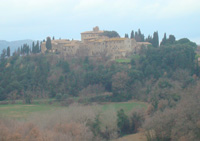 |
||||
Podere Santa Pia |
Podere Santa Pia, garden |
Castel Porrona, a charming medieval village dating back to the 11th century, between Cinigiano and Castiglioncello Bandini and Podere Santa Pia | ||
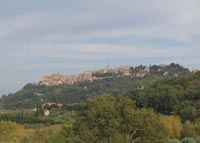 |
||||
Montepulciano |
Pienza |
The Ombrone valley, seen from Podere Santa Pia |
||
| Monticchiello is a small centre in the heart of the Orcia valley whose beauty derives from its geographical position and the harmonious integration of its medieval architecture Monticchiello is one of the most picturesque villages in the heart of the Val d'Orcia. Monticchiello still has its original city walls, towers, and castle, while the main site is the 13th century gothic church, which contains a beautiful altarpiece. Teatro Povero Every year since 1967, the ancient village of Monticchiello has been transformed into an entirely original theatre stage. The community enacts itself by means of a theatrical representation which Giorgio Strehler defined as “self-drama”. Here, the theatre originated in the square, and it is indeed the square, which represents the – even ideal – centre of the village that in summer houses the performances “created, written and performed by the people of Monticchiello”. The topics dealt with have as their background the current events of the community and their roots in the past: the rustic culture, for centuries the expert on life, swept aside by the advance of progress, wars, old and new, with their ravages, the false myths pursued and never attained. They narrate themselves so as to understand themselves and other people, to try to understand how events in the world are progressing. At Monticchiello, the theatre is also identity, testimony, civil commitment, and – thanks to the cultural excitement that accompanies it (collateral initiatives, exhibitions, meetings, study days) – constitutes an important instrument of social aggregation for the inhabitants and the devoted members of the audience. During the winter months, there is discussion on the theme to be dealt with, and preparation is begun of the texts and sets. Later on, in the square during the summer rehearsals, the ideas take on form and the contents are consolidated. Thus, the proposal of the “Teatro Povero” is born day by day. It is performed every evening for three weeks, from the end of July till the middle of August. |
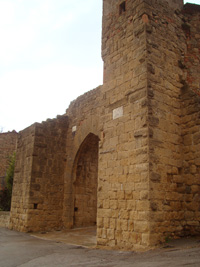 Monticchiello, one of the towers Monticchiello, one of the towers |
|||
Castiglioncello del Trinoro is a tiny village on a cliff overlooking the Orcia Valley, between La Foce and Sarteano, on the hill of Pietraporciana, a protected beech-wood has proved to be of special interest to the Italian botanical society. |
||||
Pietraporciana Nature Reserve covers the top, the northern side, and part of the southern side of the homonymous hillock (847 m), belonging to the ridge that, between Chianciano Terme and Sarteano, separates Val d’Orcia from Val di Chiana, linking up southwards with Mt. Cetona. An unusual low-altitude beech tree wood grows in the Reserve: it takes advantage of the coolness and humidity dominating the upper part of the northern slope of Poggio di Pietraporciana, at the shadow of the calcareous cliffs outcropping at the top. Riserva Naturale di Pietraporciana (it) (341 ha) |
View Natural Reserve in Tuscany of Pietraporciaia in a larger map |
|||
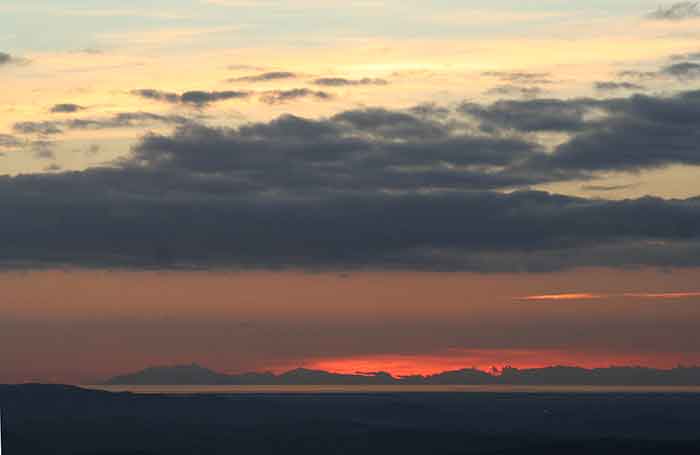 |
||||
Podere Santa Pia, evening view on the Maremma from the southern terrace |
||||
